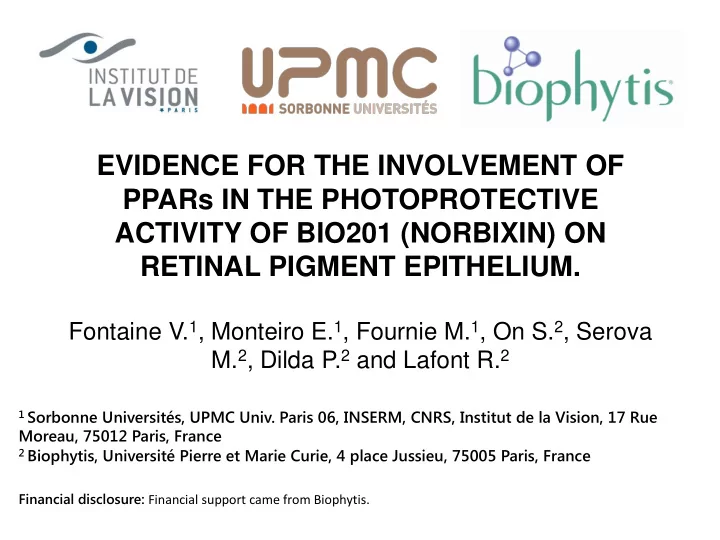

EVIDENCE FOR THE INVOLVEMENT OF PPARs IN THE PHOTOPROTECTIVE ACTIVITY OF BIO201 (NORBIXIN) ON RETINAL PIGMENT EPITHELIUM. Fontaine V. 1 , Monteiro E. 1 , Fournie M. 1 , On S. 2 , Serova M. 2 , Dilda P. 2 and Lafont R. 2 1 Sorbonne Universités, UPMC Univ. Paris 06, INSERM, CNRS, Institut de la Vision, 17 Rue Moreau, 75012 Paris, France 2 Biophytis, Université Pierre et Marie Curie, 4 place Jussieu, 75005 Paris, France Financial disclosure: Financial support came from Biophytis.
INTRODUCTION According to Herzlich (PPAR Res. 2008 Article ID 389507 ), PPARs play a key role in the protection of RPE cells against Age-Related Macular Degeneration (AMD) PPARs comprise three subtypes that can accommodate various types of ligands. The aim of the present work was to investigate the respective roles of PPAR a , PPAR b/d and PPAR g in response to BIO201 (norbixin) on the protection against the deleterious effects of A2E.
A2E sensitizes RPE cells to blue light damage and reduces PPAR a protein levels. Both effects are blunted by BIO201, a preparation of the diapo- carotenoid norbixin developed by Biophytis 1 . No significant effect is observed on other PPARs levels. PPAR a PPAR b/d PPAR g relative expression compared to DMSO relative expression compared to DMSO relative expression compared to DMSO **** 1.5 1.5 1.5 **** **** 1.0 1.0 1.0 0.5 0.5 0.5 0.0 0.0 0.0 DMSO NBX A2E NBX + A2E DMSO NBX A2E NBX + A2E DMSO NBX A2E NBX + A2E NBX: norbixin 20 µM A2E: 30 µM The effect on PPAR a is post-translational and is also observed with inverted protocols (where treatment with A2E precedes that with norbixin) 1 (Fontaine et al., PLoS ONE 2016, DOI:10.1371/journal.pone.0167793).
BIO201(norbixin) activates hPPAR a and even more efficiently hPPAR b/d Day 1 Day 2 Day 3 Day 4 Cell plating into 96- Cell transfection with pG5TkpGI3 CV1 cell plating well dark plate (reporter vector) & pGal4-hPPAR into flask (morning) Luciferase activity Norbixin treatment measurement (afternoon) hPPAR a hPPAR g hPPAR b/d Norbixin Norbixin Luciferase assay (Arbitrary units) BIO201 Luciferase assay (Arbitrary units) Luciferase assay (Arbitrary units) 0.0015 0.0025 0.8 8851% 358% *** *** 321% 0.0020 *** 202% 285% 0.6 0.0010 207% *** 231% 5219% 212% 0.0015 *** *** *** 158% 0.4 125% 0.0010 * 116% 121% 0.0005 109% 100% 52% 61% 100% 0.2 16% 50% 0.0005 1727% 281% 135% 100% 86%113% 123% 0.0000 0.0000 0.0 0,00E+00 3,00E-08 1,00E-07 3,00E-07 1,00E-06 6,00E-06 1,00E-05 3,00E-05 1,00E-04 0,00E+00 0,00E+00 1,00E-08 1,00E-07 3,00E-07 1,00E-06 3,00E-06 1,00E-05 3,00E-05 1,00E-04 3,00E-08 1,00E-07 3,00E-07 1,00E-06 6,00E-06 1,00E-05 3,00E-05 1,00E-04 Norbixin (M) BIO201 (M) Norbixin (M) Norbixin (M) Such experiments do not tell us whether these effects are direct or indirect
DIRECT BINDING TESTS (competition with radioactive ligands): BIO201 (norbixin) binds to PPAR a with a K i of 16.5 µM, and to PPAR g with a K i of 1.15 µM FRET ACTIVITY TESTS (induction of PPAR coactivator or corepressor recruitment): BIO201 (norbixin) shows no agonist effect on any of the three PPARs, but has an antagonist effect on PPAR b/d (K a ca . 3.2 µM) Effect of various pharmacological agents Compound Effect PPAR a agonist Sulindac does not protect RPE cells and does not maintain PPAR a levels PPAR a antagonist MK886 protects RPE cells and maintains PPAR a levels PPAR b/d agonist GW0742 protects RPE cells and maintains PPAR a levels PPAR b/d antagonist GSK3787 reduces protection by norbixin PPAR g agonist Troglitazone protects RPE cells and maintains PPAR a levels PPAR g antagonist T0070907 reduces protection by norbixin and troglitazone APOPTOSIS : BIO201 (norbixin) cytoprotective activity correlates with a significant reduction of both ROS levels (p<0.01) and apoptosis induction upon treatment with antimycin A.
CONCLUSIONS • These experiments have revealed the difficulty of interpreting experimental data, arising from the limited specificity of current PPAR agonists and antagonists, a potential source of multiple cross-reactions (e.g. troglitazone). • There is some discrepancy between activation studies and binding experiments, which suggests that PPAR activation is mostly indirect. • A2E induces PPAR a degradation, and all the tested compounds showing a protection of RPE cells against blue light damage in the presence of A2E are able to sustain PPAR a levels. Thus the presence of PPAR a appears required for photoprotection. • Agonists of PPAR g and PPAR b/d protect RPE cells, whereas their antagonists reduce the protective effect of BIO201 (norbixin). Thus, both PPARs seem involved in BIO201 action. • Additional strategies (siRNA, shRNA, …) are under way in order to relieve remaining ambiguities and assess definitively the role of the three PPARs in BIO201 (norbixin) protective action. • Norbixin is the active principle of BIO201 , a 97% pure 9’ -cis isomer prepared from the seeds of Bixa orellana . BIO201 has been formulated for improving its stability and per os bioavailability as Macuneos . Biophytis will start a phase 1 clinical trial in 2017 with Macuneos as an oral treatment for dry AMD. Contacts: valerie.fontaine@inserm.fr – pierre.dilda@biophytis.com
Recommend
More recommend